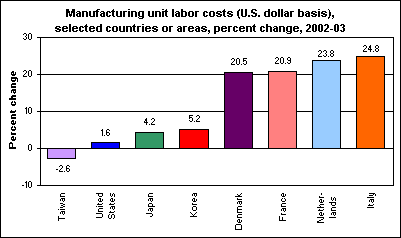October 05, 2004 (The Editor’s Desk is updated each business day.)
Manufacturing unit labor costs lower in 2003 in Taiwan
Among 13 economies for which 2003 data are available, manufacturing unit
labor costs fell in U.S. dollar terms only in Taiwan.

[Chart data—TXT]
In the United States, unit labor costs in manufacturing rose 1.6 percent in 2003.
There were double-digit increases in unit labor costs (on a U.S. dollar basis) in eight of the 13 economies studied.Â
The widespread, and mostly large, increases in unit labor costs in U.S. dollar terms are explained by the depreciation of the dollar, particularly with respect to the euro and other European currencies. The U.S. dollar depreciated against the currencies of all the economies compared, but the depreciation was very slight versus the Taiwan dollar.
These data are from the BLS Foreign Labor Statistics program.
Data are subject to revision. For more information, see news release,
"International Comparisons of Manufacturing Productivity and Unit Labor Cost Trends,
2003" (PDF) (TXT),
USDL 04-1945. Unit labor costs are defined as the cost of labor input required to produce one unit of output. They are computed as labor compensation in nominal terms divided by real output.
Related TED article:Â
Of interest
Spotlight on Statistics: National Hispanic Heritage Month
In this Spotlight, we take a look at the Hispanic labor force—including labor force participation, employment and unemployment, educational attainment, geographic location, country of birth, earnings, consumer expenditures, time use, workplace injuries, and employment projections.
.
Read more »
